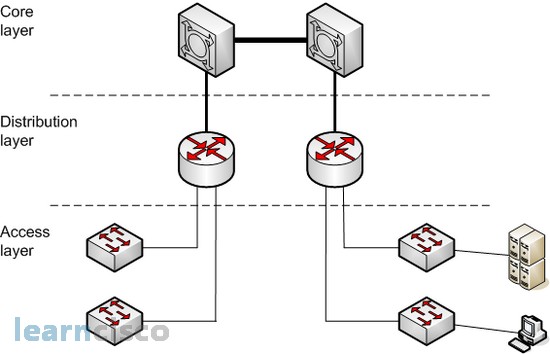The Cisco hierarchical model can help you design, implement, and maintain a scalable, reliable, cost-effective hierarchical internetwork. Cisco defines three layers of hierarchy, as it is shown below, each with specific functions. The following are the three layers and their typical functions:
- The core layer: Backbone
- The distribution layer: Routing
- The access layer: Switching

The Core Layer
The core layer is literally the core of the network. At the top of the hierarchy, the core layer is responsible for transporting large amounts of traffic both reliably and quickly. The only purpose of the network’s core layer is to switch traffic as fast as possible. The traffic transported across the core is common to a majority of users. However, user data is processed at the distribution layer, which forwards the requests to the core if needed. If there is a failure in the core, every single user can be affected. Therefore, fault tolerance at this layer is an issue. The core is likely to see large volumes of traffic, so speed and latency are driving concerns here. Given the function of the core, here are some things we don’t want to do:
- Don’t do anything to slow down traffic. This includes using access lists, routing between virtual local area networks (VLANs), and packet filtering.
- Don’t support workgroup access here.
- Avoid expanding the core (i.e., adding routers) when the internetwork grows. If performance becomes an issue in the core, give preference to upgrades over expansion.
Now, there are a few things that we want to do as we design the core:
- Design the core for high reliability. Consider data-link technologies that facilitate both speed and redundancy, such as FDDI, Fast Ethernet (with redundant links), or even ATM.
- Design with speed in mind. The core should have very little latency.
- Select routing protocols with lower convergence times. Fast and redundant data-link connectivity is no help if your routing tables are shot!
The Distribution Layer
The distribution layer is sometimes referred to as the workgroup layer and is the communication point between the access layer and the core. The primary functions of the distribution layer are to provide routing, filtering, and WAN access and to determine how packets can access the core, if needed. The distribution layer must determine the fastest way that network service requests are handled-for example, how a file request is forwarded to a server. After the distribution layer determines the best path, it forwards the request to the core layer if needed. The core layer then quickly transports the request to the correct service. The distribution layer is the place to implement policies for the network. Here you can exercise considerable flexibility in defining network operation. And here are several actions that generally should be done at the distribution layer:
- Routing
- Implementation of tools such as access lists, of packet filtering, and of queuing
- Implementation of security and network policies, including address translation and firewalls
- Redistribution between routing protocols, including static routing
- Routing between VLANs and other workgroup support functions
- Definitions of broadcast and multicast domains
The Access Layer
The access layer controls user and workgroup access to internetwork resources. The access layer is sometimes referred to as the desktop layer. The network resources most users need will be available locally. The distribution layer handles any traffic for remote services. The following are some of the functions to be included at the access layer:
- Continued (from distribution layer) access control and policies
- Creation of separate collision domains (segmentation)
- Workgroup connectivity into the distribution layer
Technologies such as DDR and Ethernet switching are frequently seen in the access layer. Static routing (instead of dynamic routing protocols) is seen here as well.
Our Recommended Premium CCNA Training Resources
These are the best CCNA training resources online:
Click Here to get the Cisco CCNA Gold Bootcamp, the most comprehensive and highest rated CCNA course online with a 4.8 star rating from over 30,000 public reviews. I recommend this as your primary study source to learn all the topics on the exam.

Want to take your practice tests to the next level? AlphaPreps purpose-built Cisco test engine has the largest question bank, adaptive questions, and advanced reporting which tells you exactly when you are ready to pass the real exam. Click here for your free trial.
